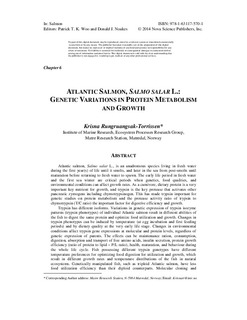| dc.description.abstract | Atlantic salmon, Salmo salar L., is an anadromous species living in fresh water during the first year(s) of life until it smolts, and later in the sea from post-smolts until maturation before returning to fresh water to spawn. The early life period in fresh water and the first sea winter are critical periods when genetics, food qualities, and environmental conditions can affect growth rates. As a carnivore, dietary protein is a very important key nutrient for growth, and trypsin is the key protease that activates other pancreatic zymogens including chymotrypsinogen. This has made trypsin important for genetic studies on protein metabolism and the protease activity ratio of trypsin to chymotrypsin (T/C ratio) the important factor for digestive efficiency and growth. Trypsin has different isoforms. Variations in genetic expression of trypsin isozyme patterns (trypsin phenotypes) of individual Atlantic salmon result in different abilities of the fish to digest the same protein and optimize food utilization and growth. Changes in trypsin phenotypes can be induced by temperature (at egg incubation and first feeding periods) and by dietary quality at the very early life stage. Changes in environmental conditions affect trypsin gene expressions at molecular and protein levels, regardless of genetic expression of parents. The effects can be maintenance ration, consumption, digestion, absorption and transport of free amino acids, insulin secretion, protein growth efficiency (ratio of protein to lipid – P/L ratio), health, maturation, and behaviour during the whole life cycle. Fish possessing different trypsin genotypes have different temperature preferences for optimizing food digestion for utilization and growth, which result in different growth rates and temperature distributions of the fish in natural ecosystems. Genetically manipulated fish, such as triploid Atlantic salmon, have less food utilization efficiency than their diploid counterparts. Molecular cloning and characterization of trypsin isozymes show very little genetic variation in trypsin genes. So far, trypsin clones and trypsin isozymes have never been matched, probably due to too few differences in sequences and the knowledge of gene expression is still limited. Studies on trypsin genotypes have provided new insights that can be exploited and integrated into other research fields to elucidate genetics of growth performance quality through food utilization under different environmental conditions | |
